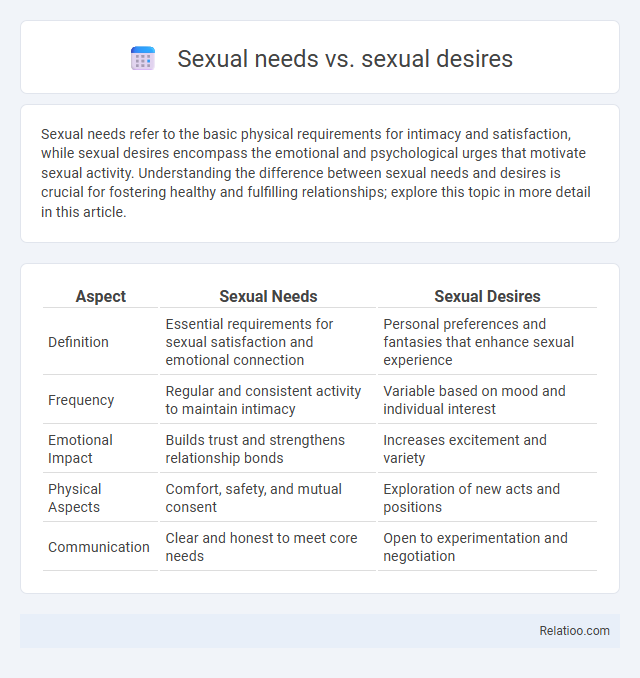Sexual needs refer to the basic physical requirements for intimacy and satisfaction, while sexual desires encompass the emotional and psychological urges that motivate sexual activity. Understanding the difference between sexual needs and desires is crucial for fostering healthy and fulfilling relationships; explore this topic in more detail in this article.
Table of Comparison
| Aspect | Sexual Needs | Sexual Desires |
|---|---|---|
| Definition | Essential requirements for sexual satisfaction and emotional connection | Personal preferences and fantasies that enhance sexual experience |
| Frequency | Regular and consistent activity to maintain intimacy | Variable based on mood and individual interest |
| Emotional Impact | Builds trust and strengthens relationship bonds | Increases excitement and variety |
| Physical Aspects | Comfort, safety, and mutual consent | Exploration of new acts and positions |
| Communication | Clear and honest to meet core needs | Open to experimentation and negotiation |
Understanding Sexual Needs: Definition and Importance
Sexual needs refer to the essential physical and emotional requirements that sustain an individual's intimate well-being, while sexual desires encompass the personal attractions and fantasies that drive sexual interest. Your understanding of sexual needs is crucial because it forms the foundation for healthy relationships and self-awareness, ensuring that your emotional and physical boundaries are respected. Sexual alignment occurs when your sexual needs and desires are compatible with those of your partner, fostering mutual satisfaction and emotional connection.
Defining Sexual Desires: Beyond Basic Needs
Sexual desires represent the complex emotional and psychological attractions that go beyond fulfilling basic sexual needs, encompassing fantasies, preferences, and individual sexual expression. These desires vary greatly between individuals and shape your unique sexual identity and satisfaction, influencing how you seek intimacy and connection. Understanding sexual desires requires recognizing their role in emotional fulfillment and personal pleasure, distinct from mere biological needs or fixed sexual alignment labels.
Key Differences Between Sexual Needs and Desires
Sexual needs refer to the essential physical and emotional requirements necessary for personal well-being and intimacy, while sexual desires are the subjective impulses or wants that vary based on individual preferences and fantasies. Sexual alignment involves how one's sexual identity, orientation, and preferences harmonize with their partner's, creating mutual satisfaction. Understanding these distinctions helps you recognize that meeting sexual needs supports health and connection, whereas fulfilling desires drives passion and variety.
Biological Basis of Sexual Needs
Sexual needs arise from biological drives regulated by hormones such as testosterone and estrogen, influencing your body's imperative for reproductive and physical intimacy. Sexual desires encompass both biological impulses and psychological factors, reflecting individual preferences and emotional connections. Sexual alignment refers to the congruence between your inherent sexual orientation and behaviors, often rooted in neurological and hormonal patterns established during development.
Psychological Influences on Sexual Desires
Psychological influences on sexual desires involve complex interactions between emotions, mental health, and past experiences, shaping an individual's unique sexual needs, desires, and alignment. Sexual needs refer to the fundamental requirements for physical intimacy and connection, while sexual desires encompass personal wants and fantasies influenced by mood, stress levels, and relational dynamics. Sexual alignment reflects the congruence between one's sexual orientation, preferences, and psychological state, highlighting how cognitive and emotional factors critically impact sexual expression and satisfaction.
How Sexual Needs Impact Relationships
Sexual needs refer to essential physical and emotional requirements for intimacy, while sexual desires involve preferences and fantasies that vary between individuals. Your understanding and communication of these needs are crucial in fostering trust, satisfaction, and emotional connection within relationships. Sexual alignment, or the compatibility of each partner's sexual needs and desires, significantly impacts relationship stability and overall happiness.
Navigating Conflicts Between Needs and Desires
Sexual needs refer to essential physical and emotional requirements for intimacy, while sexual desires encompass personal preferences and fantasies that enhance pleasure. Sexual alignment occurs when partners share compatible needs and desires, fostering harmony in their relationship. Navigating conflicts between your sexual needs and desires involves open communication, mutual respect, and exploring compromises that satisfy both partners' core requirements and aspirations.
The Role of Communication in Sexual Fulfillment
Sexual needs, desires, and alignment represent distinct yet interconnected aspects of human sexuality, where needs refer to essential physical and emotional requirements, desires to personal preferences and fantasies, and alignment to the compatibility between partners' sexual orientations and preferences. Effective communication ensures partners articulate and understand each other's sexual needs and desires, facilitating mutual respect and adapting to evolving sexual alignments. Open dialogue fosters emotional intimacy and reduces misunderstandings, playing a crucial role in achieving sexual fulfillment and relationship satisfaction.
Myths and Misconceptions About Sexual Needs vs Desires
Sexual needs refer to the fundamental biological or emotional requirements essential for individual well-being, whereas sexual desires are the varying personal interests and fantasies that can fluctuate over time. Many myths confuse these concepts, wrongly assuming that unmet desires always indicate unmet needs or that all sexual alignment perfectly matches both needs and desires. Understanding these distinctions helps you better navigate relationships and communicate your unique sexual alignment without falling prey to misconceptions.
Building a Healthy Balance: Meeting Both Needs and Desires
Sexual needs refer to the essential biological and emotional aspects required for well-being, while sexual desires involve personal preferences and fantasies that enhance intimacy and pleasure. Sexual alignment occurs when partners share compatible needs, desires, and values, fostering mutual satisfaction and connection. Building a healthy balance requires open communication, respect for boundaries, and ongoing negotiation to meet both partners' essential needs and evolving desires, promoting relationship harmony and sexual fulfillment.

Infographic: Sexual needs vs sexual desires
 relatioo.com
relatioo.com